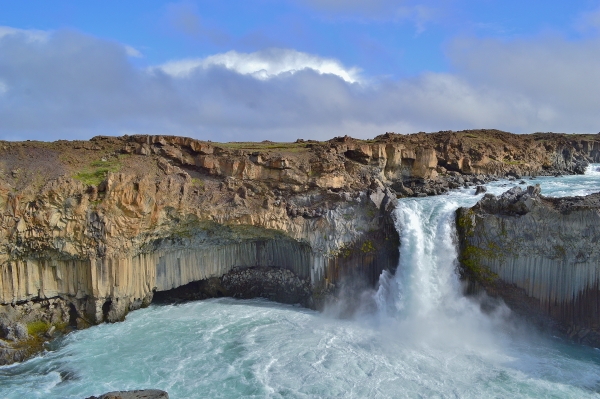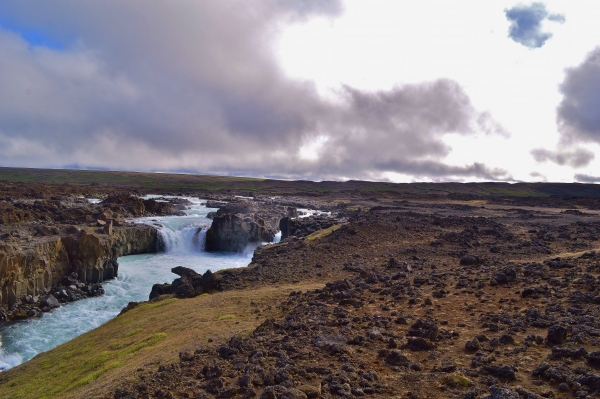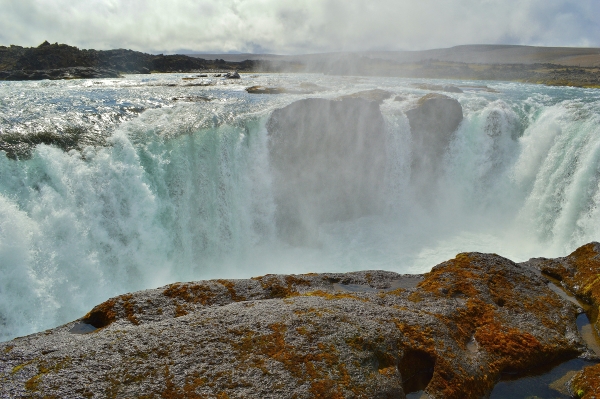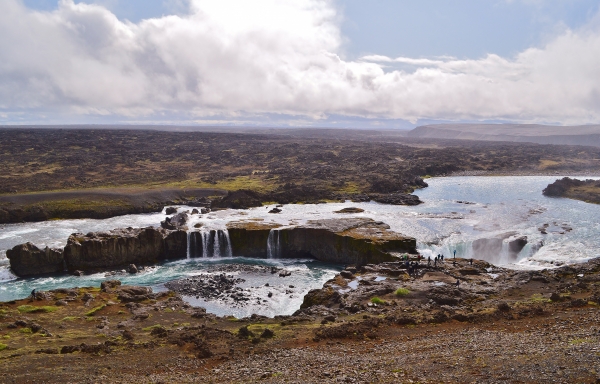Skjálfandafljót river is one of the most magnificent rivers in Iceland. Situated in North Iceland it has its source at the north-western edge of Vatnajökull glacier. It flows south, parallel to the Sprengisandur mountain road (F26), emptying into the Skjálfandi bay. It is the fourth largest river in Iceland, measured by water flow. It is also home to some of the most spectacular waterfalls in Iceland.
A chain of spectacular waterfalls
The best known waterfall in Skjálfandafjót river is Goðafoss waterfall, just off the ring road. Goðafoss is one of the most powerful and beautiful waterfalls in Iceland. While Goðafoss is one of the most popular tourist attractions in Iceland, visited by large crowds of travellers each year, fewer people visit the other spectacular waterfalls of Skjálfandifljót river. Just 40 km (25 miles) up the river is a chain of three waterfalls which are no less dramatic and magnificent than Goðafoss.
All three waterfalls, Aldeyjarfoss, Ingvararfoss and Hrafnabjargafoss will be destroyed if the most ambitious plans of Landsvirkjun are realized. As the photographs demonstrate all three are quite spectacular.
Hrafnabjörg Power Plant
The plan, called Hrafnabjargavirkjun, or Hrafnabjörg Power Plant, envisions a dam on Skjálfandifljót by the Hrafnabjörg cliffs. The dam would create a 26 km2 (10 sqm) reservoir and divert water away from a long stretch of the river downstream. The reservoir will not only cover large swathes of grown land, it is also quite large, which can be seen by comparing it to Mývatn lake, which measures 37 km2 (14.3 sqm).
Read more: Organisations start a petition to try and save the highlands from developments
The plan has been on the drawing boards for decades, but a few years ago Landsvirkjun, the Icelandic National Power Company unveiled plans for an 88.5 MW power plant which would have completely eliminated all three waterfalls. After outrage by locals and environmentalists Landsvirkjun drew up two further options. Instead of Option A, for 88.5 MW power plant which would have diverted water from all three waterfalls, a Option B and Option C, which envisioned a smaller power plant sparing the northernmost of the three waterfalls, Aldeyjarfoss, were drawn up.
Option B, for a 50 MW power plant, spared Aldeyjarfoss, but still envisioned the diversion of a nearby river, Suðurá, into the reservoir as Option A did. Finally an Option C, for a 36.5 MW power plant, did not divert Suðurá into the reservoir, thus affecting neither Suðurá or Svartá, and a waterfall in Svartá Ullarfoss would not be affected.

Aldeyjarfoss
Aldeyjarfoss is the best known of the three waterfalls. Aldeyjarfoss is within a short walking distance from the road to Sprengisandur. It was not very well known until Landsvirkjun unveiled its plans to build a dam on the Skjálfandifljót river, but following national attention and campaigning by both locals and environmental activists it has received a high profile status, becoming a popular tourist destination.
Plan A of Landsvirkjun, the Icelandic National Power Company would mean Aldeyjarfoss waterfall would be without water as the river would be diverted away from it.


Ingvararfoss
After Aldeyjarfoss became nationally known Landsvirkjun came up with new and more limited plans for a smaller power plant which would protected Aldeyjarfoss, but these plans still mean two magnificent waterfalls will disappear. Environmentalists stress that the three waterfalls form a dramatic chain of three large waterfalls on a short stretch of river, within easy hiking distance from one another. The middle one is Ingvararfoss, just a short distance upriver from Aldeyjarfoss. Ingvararfoss is not marked on signposts, and few travellers are aware of its existence, but a marked hiking path could change this and provide local tourism with a significant boost.
Both plans B and C would mean Ingvararfoss would virtually disappear.

Hrafnabjargafoss
Similarly, both plans B and C would see Hrafnabjargafossand Ingvararfoss waterfalls disappear, despite sparing Aldeyjarfoss waterfall. With that Iceland would lose one of its most beautiful hidden waterfalls, Hrafnabjargafoss. Falling in two parts, on either side of a large rocky outcropping, or island in the middle of the stream, it has all the features which make Icelandic waterfalls magical. Its eastern and northern part is composed of cascading rapids, and small streams which pour over the side of the island, while its western and southern part is a thundering waterfall which falls into a concentrated bowl, tunnelling under a low stone arch before flowing back out into the river.
Under no scenario of the proposed power plant can Hrafnabjargafoss be spared.

The plans for Hrafnabjargavirkjun, plans A, B and C are currently being considered by a panel of experts who will determine if the plan will be recommended to be moved ahead or shelved permanently. The experts consider both economic and environmental factors, including the aesthetic value of natural formations which are likely to be permanently altered by the project. The final decision is ultimately a political decision.
When these decisions are made it is crucial that officials keep in mind that waterfalls like those of Skjálfandifljót river are unique and irreplaceable.
Skjálfandafljót river is one of the most magnificent rivers in Iceland. Situated in North Iceland it has its source at the north-western edge of Vatnajökull glacier. It flows south, parallel to the Sprengisandur mountain road (F26), emptying into the Skjálfandi bay. It is the fourth largest river in Iceland, measured by water flow. It is also home to some of the most spectacular waterfalls in Iceland.
A chain of spectacular waterfalls
The best known waterfall in Skjálfandafjót river is Goðafoss waterfall, just off the ring road. Goðafoss is one of the most powerful and beautiful waterfalls in Iceland. While Goðafoss is one of the most popular tourist attractions in Iceland, visited by large crowds of travellers each year, fewer people visit the other spectacular waterfalls of Skjálfandifljót river. Just 40 km (25 miles) up the river is a chain of three waterfalls which are no less dramatic and magnificent than Goðafoss.
All three waterfalls, Aldeyjarfoss, Ingvararfoss and Hrafnabjargafoss will be destroyed if the most ambitious plans of Landsvirkjun are realized. As the photographs demonstrate all three are quite spectacular.
Hrafnabjörg Power Plant
The plan, called Hrafnabjargavirkjun, or Hrafnabjörg Power Plant, envisions a dam on Skjálfandifljót by the Hrafnabjörg cliffs. The dam would create a 26 km2 (10 sqm) reservoir and divert water away from a long stretch of the river downstream. The reservoir will not only cover large swathes of grown land, it is also quite large, which can be seen by comparing it to Mývatn lake, which measures 37 km2 (14.3 sqm).
Read more: Organisations start a petition to try and save the highlands from developments
The plan has been on the drawing boards for decades, but a few years ago Landsvirkjun, the Icelandic National Power Company unveiled plans for an 88.5 MW power plant which would have completely eliminated all three waterfalls. After outrage by locals and environmentalists Landsvirkjun drew up two further options. Instead of Option A, for 88.5 MW power plant which would have diverted water from all three waterfalls, a Option B and Option C, which envisioned a smaller power plant sparing the northernmost of the three waterfalls, Aldeyjarfoss, were drawn up.
Option B, for a 50 MW power plant, spared Aldeyjarfoss, but still envisioned the diversion of a nearby river, Suðurá, into the reservoir as Option A did. Finally an Option C, for a 36.5 MW power plant, did not divert Suðurá into the reservoir, thus affecting neither Suðurá or Svartá, and a waterfall in Svartá Ullarfoss would not be affected.

Aldeyjarfoss
Aldeyjarfoss is the best known of the three waterfalls. Aldeyjarfoss is within a short walking distance from the road to Sprengisandur. It was not very well known until Landsvirkjun unveiled its plans to build a dam on the Skjálfandifljót river, but following national attention and campaigning by both locals and environmental activists it has received a high profile status, becoming a popular tourist destination.
Plan A of Landsvirkjun, the Icelandic National Power Company would mean Aldeyjarfoss waterfall would be without water as the river would be diverted away from it.


Ingvararfoss
After Aldeyjarfoss became nationally known Landsvirkjun came up with new and more limited plans for a smaller power plant which would protected Aldeyjarfoss, but these plans still mean two magnificent waterfalls will disappear. Environmentalists stress that the three waterfalls form a dramatic chain of three large waterfalls on a short stretch of river, within easy hiking distance from one another. The middle one is Ingvararfoss, just a short distance upriver from Aldeyjarfoss. Ingvararfoss is not marked on signposts, and few travellers are aware of its existence, but a marked hiking path could change this and provide local tourism with a significant boost.
Both plans B and C would mean Ingvararfoss would virtually disappear.

Hrafnabjargafoss
Similarly, both plans B and C would see Hrafnabjargafossand Ingvararfoss waterfalls disappear, despite sparing Aldeyjarfoss waterfall. With that Iceland would lose one of its most beautiful hidden waterfalls, Hrafnabjargafoss. Falling in two parts, on either side of a large rocky outcropping, or island in the middle of the stream, it has all the features which make Icelandic waterfalls magical. Its eastern and northern part is composed of cascading rapids, and small streams which pour over the side of the island, while its western and southern part is a thundering waterfall which falls into a concentrated bowl, tunnelling under a low stone arch before flowing back out into the river.
Under no scenario of the proposed power plant can Hrafnabjargafoss be spared.

The plans for Hrafnabjargavirkjun, plans A, B and C are currently being considered by a panel of experts who will determine if the plan will be recommended to be moved ahead or shelved permanently. The experts consider both economic and environmental factors, including the aesthetic value of natural formations which are likely to be permanently altered by the project. The final decision is ultimately a political decision.
When these decisions are made it is crucial that officials keep in mind that waterfalls like those of Skjálfandifljót river are unique and irreplaceable.







